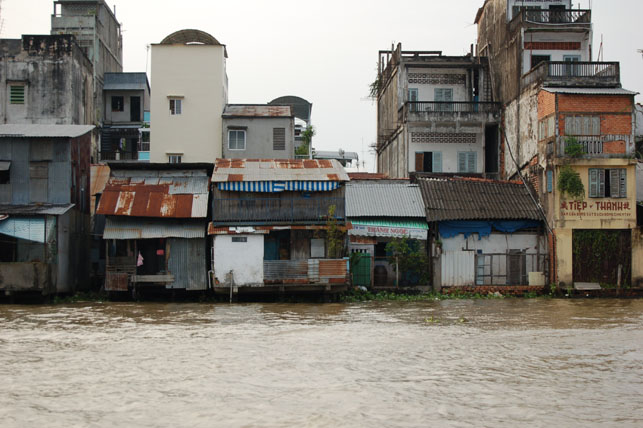You are here
| Attachment | Size |
|---|---|
| 2.52 MB | |
| 3.57 MB |

Tidal flooding at the edge of shops and homes in Can Tho, Vietnam. Photo Cristina Rumbatis del Rio
For centuries, residents around Can Tho, a city of 1.1m people in southern Vietnam, just 0.8m above sea level, have depended on flood cycles to grow crops. However, experts warn there is a possibility that sea levels will rise in the delta region around Can Tho due to climate change, causing devastating floods that will displace millions and destroy those crops.
Can Tho is in the wider Mekong Delta, a rice-growing region that spans southern Vietnam and is home to 18 million people. More than half of Vietnam's rice is produced in the delta, as well as 60 percent of its fish and shrimp.
A 1m sea-level rise could displace more than seven million residents of the Mekong delta, and a 2m sea-level rise could double that number, according to a study on Mapping the Effects of Climate Change on Human Migration and Displacement (see attached) by the Columbia University Center for International Earth Science Information Network in New York, the UN Refugee Agency (UNHCR), and other groups.
The delta is where the Mekong River divides into nine channels after a 5,000km journey from the Tibetan plateau. It is "particularly susceptible" to sea-level rises, says Alex de Sherbinin, a senior research associate at the Columbia University Center. A 1m sea-level rise is "definitely within the bounds" of happening this century, he told IRIN. A 2m sea-level rise, however, is less likely.
The study examined the major deltas of the world, and was based on current patterns of climate change and migration for glacier melt, as well as interviews with displaced residents.
According to the Fourth Assessment Report of the Intergovernmental Panel on Climate Change (IPCC), considered the most authoritative group on the topic, millions of people in deltas in Vietnam, Bangladesh and Egypt will be directly affected by sea-level rises by the end of this century.
Bracing for changes
Although Vietnam has always been vulnerable to adverse weather, climate change "is making the hazards worse", says Koos Neefjes, a climate change policy adviser to the UN Development Programme (UNDP) in Vietnam.
Recent climate change in Vietnam is beyond the level of natural change, argues a 2009 report by by the UN Environment Programme: Viet Nam Assessment Report On Climate Change (VARCC) (see attached) In the past 50 years, temperatures have increased by 0.05-0.20 degrees Celsius, and sea level has increased by 2-4 cm per decade, the report warns.
In the past 15 years, the country has experienced severe floods, although they are caused by a combination of factors, including deforestation and typhoons.
In 2000 and 2001, the worst torrents in recent history killed more than 500 people, many of them children. Significant tracts of farmland were inundated for months, destroying their crop-growing capabilities.
"There is time to handle that additional threat from climate change," Neefjes told IRIN. "In a sense it is more urgent to address the development gap, the threats that have existed for years and that make this country in many parts not safe enough."
Living with floods
The government has a policy called "living with floods" that tries to maximize good effects and minimize the bad effects of floods - rather than ending them through measures deemed too costly.
"A flood adaptation policy is better than eliminating them," said Vo Thanh Danh, a researcher at the Institute of Climate Change Study at Cantho University. "Even floods bring more benefits than losses if we can live with and adapt to floods."
Since 1998, authorities have been trying to relocate 200,000 households - about one million people - to less flood-prone areas.
The programme also tries to promote behavioural changes, such as encouraging villagers to switch to aquaculture from agriculture. Authorities have been teaching children to swim and equipping them with buoys. They are also constructing food compartments in ceilings that stay dry during floods, along with fresh water storage facilities.
Mekong delta residents are using rice varieties that can withstand fluctuations in water level and salinity. Still, much more work is needed, Neefjes said. "City planning must expand into better places, [such as higher ground]."
Without dyke reinforcements and improved drainage, a 1m rise in sea levels along the coast of Vietnam would inundate 5.3 percent of Vietnam's total land area, reveals a 2010 government report.
Of that total, the sea-level rise could swamp more than 80 percent of the Mekong Delta, 9 percent in the Red River Delta in northern Vietnam, and 4 percent each in the north-central coast and southeast regions - an area that includes Ho Chi Minh City, the country's largest metropolis of 7.1 million people.
Source: IRIN
Date: 20 May 2011



Recent Comments